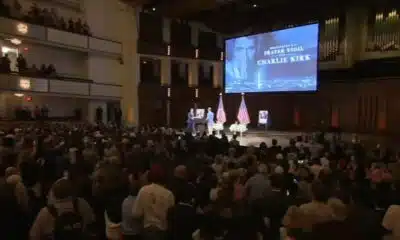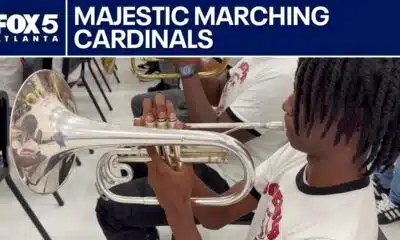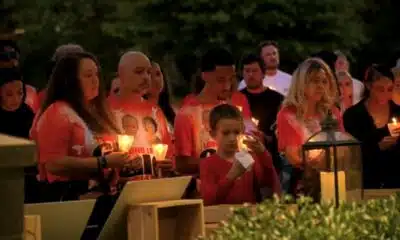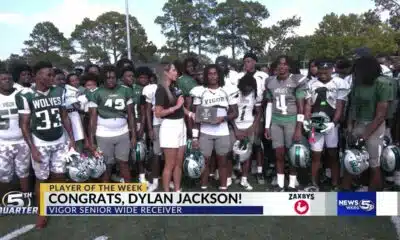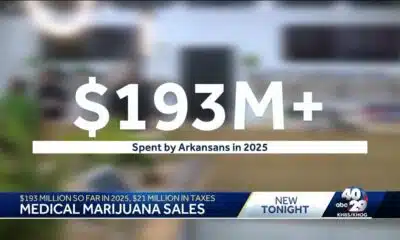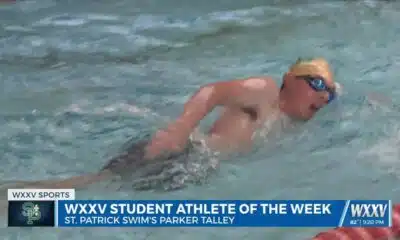News from the South - Virginia News Feed
Va. Democrats criticize Trump’s order to close education department as governor touts readiness
Va. Democrats criticize Trump’s order to close education department as governor touts readiness
by Nathaniel Cline, Virginia Mercury
March 24, 2025
With the federal government attempting to shut down the Department of Education, Virginia is now considering how the move will impact operations in the commonwealth.
State Democrats and some parents and advocates have expressed concern with President Donald Trump’s signing on Thursday of the executive order directing U.S. Secretary of Education Linda McMahon to close the agency and move specific operations to other federal agencies.
However, Republicans, including Gov. Glenn Youngkin, believe Virginia is ready for the opportunity that the executive order provides, giving states control over how they run public education.
“Virginia is ready to take full responsibility for K-12 education,” said Youngkin, in a statement on Thursday, adding that the commonwealth has created a “high-expectations” agenda that sets strict standards, holds schools accountable and directs resources to those in greatest need.
“We welcome the federal government’s shift of responsibility to the states — and we are grateful that President Trump’s executive order does just that,” Youngkin stated. “The EO also makes it clear that there will be no discrimination in the classrooms. We will continue to ensure every student graduates career-, college-, or military-ready.”
Senate Democrats projected that states nationwide, including Virginia, will “suffer greatly” because of the “illegal” order. The group also said that Trump’s decision is “another check” off of his Project 2025 bucket list, referring to the proposal to shift control of education funding and oversight to states.
“When we think of Trump’s push to dismantle the Department of Education, we think of George Wallace standing in the schoolhouse door, blocking Black students from entering. It brings back memories of Virginia engaging in massive resistance,” read a statement by Virginia Senate Democrats. “This effort to push education back to the states is designed to roll back all efforts at progress since the 1954 Brown v Board of Education decision.
“Trump and his minions clearly want to limit educational opportunities. When will the madness end?”
Can the agency close?
Some Virginia leaders, including Del. Tom Garrett, R-Buckingham, are not sold on Trump’s ability to close the agency by signing the order.
Garrett said if Congress established the agency, then it would be up to Congress to abolish it. However, the delegate said that the executive order allows Trump to reform the department, downsize it, and redefine it within the context of the law.
“It relinquishes a great deal of federal control over education and relinquishes that control to the respective states, which is where that control was until the Carter Administration. Frankly, if student achievement versus the world is the benchmark, the DOE has been an abject failure and is in dire need of reform,” Garrett said. “To that end, I applaud the [Trump] Administration, as perhaps now our student achievement versus the world will once again improve instead of declining.”
Matt Hurt, director of the Comprehensive Instructional Program consortium, which is geared to improve student achievement in Virginia, also questioned if the public is falling for “political theater,” considering Congress, not a presidential order, would be responsible for dissolving the federal agency.
One thing that should be clear, Hurt said, is that federal funding and the U.S. Department of Education should be considered separate from one another.
“The U.S. Department of Education does not create or levy or bring to the table funds in and of themselves. All they do is distribute the funds that have been allocated by Congress,” Hurt said.
Looking ahead
Pending the litigation and Congressional battle expected to result from Trump’s order, Virginia could likely need additional support to continue providing the services and resources the federal agency has since its establishment in 1979, including ensuring equal educational opportunity and supporting schools, teachers, and research to improve learning outcomes.
U.S. Sen. Tim Kaine, D-Va., told reporters on a March 6 call that the Virginia Department of Education is not equipped to take on the responsibilities of a dismantled federal education agency — particularly when it comes to one notable area: special education.
Virginia’s education department has a blemished history concerning special education and has weathered claims that the agency failed to meet requirements to support students with disabilities.
The department, however, turned things around after the U.S. Department of Education’s Office of Civil Rights investigated and concluded that the state agency met all of its findings and recommendations. However, some advocates still believe there are unresolved issues.
Questions are also being raised about what Virginia will do if it receives a federal block grant and how it will appropriately distribute those funds to schools, including for at-risk students. The block grant is a large sum of federal funds used primarily for programs that support students that come from low-income families and English learners.
A dozen education leaders nationwide have recently urged McMahon to distribute federal dollars through block grants rather than funding streams with strict spending requirements. They argue that giving states more flexibility would help address issues like rural school funding, achievement gaps and workforce readiness.
Virginia Secretary of Education Aimee Rogstad Guidera said in a statement that while Trump’s order will ensure federal funding will arrive with fewer restrictions, it will also allow the commonwealth to “invest those resources in the most efficient and effective ways that lead to the ultimate goal of improving student outcomes.”
The state education department is also undergoing leadership changes, after Lisa Coons recently resigned as superintendent of public instruction.
Emily Anne Gullickson, former chief deputy secretary of education, will address the public for the first time as the interim superintendent at the Board of Education’s work session on Wednesday.
Board of Education President Grace Creasey said Trump’s move to shut down the nation’s education department “empowers” parents and reduces federal overreach.
“For too long, bureaucrats in Washington have dictated one-size-fits-all policies that fail to address the unique needs of the commonwealth’s students and schools,” Creasey said in a statement. “Returning decision-making authority and funding to the states can foster innovation, accountability, and better educational outcomes. This is about putting parents and state and local leaders back in charge of education.”
GET THE MORNING HEADLINES.
Virginia Mercury is part of States Newsroom, a nonprofit news network supported by grants and a coalition of donors as a 501c(3) public charity. Virginia Mercury maintains editorial independence. Contact Editor Samantha Willis for questions: info@virginiamercury.com.
The post Va. Democrats criticize Trump’s order to close education department as governor touts readiness appeared first on virginiamercury.com
News from the South - Virginia News Feed
Some employers take action against employees for social media comments on Charlie Kirk's death
SUMMARY: Following Charlie Kirk’s death, some Virginia employers have taken action against employees who made controversial social media comments. In healthcare and education sectors, individuals were placed on leave or terminated for remarks deemed unprofessional or supportive of violence. Riverside Walter Reed Hospital fired an anesthesiologist, and Newport News and Accomack County schools disciplined staff members. Experts highlight the blurred line between personal expression and professional conduct due to social media’s reach. William and Mary law professor Margaret Hugh emphasized that employment laws and at-will policies allow employers broad authority to act. She urges unity and respect amid heightened tensions.
Some Virginia employers are taking action against employees for social media comments made regarding Charlie Kirk’s death. A legal expert weighed in on where the line is drawn.
Subscribe: https://www.youtube.com/user/wvectv/?sub_confirmation=1
Download the 13News Now app: https://bit.ly/13NewsNowApp
Watch 13News Now+ for free on streaming: https://www.13newsnow.com/13NewsNowPlus
Check out our website: https://www.13newsnow.com/
Like us on Facebook: https://www.facebook.com/13newsnow/
Follow us on X/Twitter: https://x.com/13newsnow
Follow us on Instagram: https://www.instagram.com/13newsnow/
News from the South - Virginia News Feed
Area of interest forms in the Atlantic
SUMMARY: On September 11, 2025, Chief Meteorologist Tim Pandages reported on Hurricane Hub Live about tropical developments in the Atlantic and eastern Pacific. In the Atlantic, a low-chance area of interest near the Cabo Verde Islands may become Tropical Storm Gabrielle but requires favorable conditions. Recent tropical waves have struggled due to stable atmospheric conditions. Models show possible development east of the Leeward Islands with a likely recurving path away from Bermuda. In the eastern Pacific, Tropical Depression 13E has formed, expected to become Hurricane Mario, the season’s 8th hurricane. The Atlantic has had only one hurricane so far, Major Hurricane Aaron. Activity is expected to increase into October.
The newly formed area of interest could become Invest 92-L off the coast of Africa. Find out about that and more during tonight’s episode of Hurricane Hub LIVE! Livestream from Thursday, September 11, 2025.
Subscribe: https://www.youtube.com/user/wvectv/?sub_confirmation=1
Download the 13News Now app: https://bit.ly/13NewsNowApp
Watch 13News Now+ for free on streaming: https://www.13newsnow.com/13NewsNowPlus
Check out our website: https://www.13newsnow.com/
Like us on Facebook: https://www.facebook.com/13newsnow/
Follow us on X/Twitter: https://x.com/13newsnow
Follow us on Instagram: https://www.instagram.com/13newsnow/
News from the South - Virginia News Feed
Cat cafes, chromotherapy and pumpkin delivery: Here’s what’s new in RVA this September
SUMMARY: This September in RVA, Patch to Porch RVA delivers handpicked pumpkins from local farms, offering design, setup, and cleanup services for homes and events in Richmond, Henrico, and Chesterfield. Shore Pump introduces Beam Light Sauna, featuring infrared sauna and chromotherapy, promoting detox, skin renewal, and wellness with customizable sessions and memberships. The Fan now hosts River City’s first cat café, The Perfect Bean, combining a coffee bar with an adoptable cat lounge upstairs. Sourced locally, their drinks include seasonal, cat-themed specials. Cats come from Purring Hearts VA rescue, offering adoption opportunities, fostering community engagement and animal welfare.
What’s New in RVA is dedicated to informing you about the latest happenings in the Richmond area.
-
News from the South - Kentucky News Feed7 days ago
Lexington man accused of carjacking, firing gun during police chase faces federal firearm charge
-
News from the South - Alabama News Feed7 days ago
Zaxby's Player of the Week: Dylan Jackson, Vigor WR
-
News from the South - Arkansas News Feed7 days ago
Arkansas medical marijuana sales on pace for record year
-
News from the South - North Carolina News Feed5 days ago
What we know about Charlie Kirk shooting suspect, how he was caught
-
News from the South - Missouri News Feed7 days ago
Local, statewide officials react to Charlie Kirk death after shooting in Utah
-
Local News7 days ago
US stocks inch to more records as inflation slows and Oracle soars
-
Local News6 days ago
Russian drone incursion in Poland prompts NATO leaders to take stock of bigger threats
-
Local News Video6 days ago
Introducing our WXXV Student Athlete of the Week, St. Patrick’s Parker Talley!





